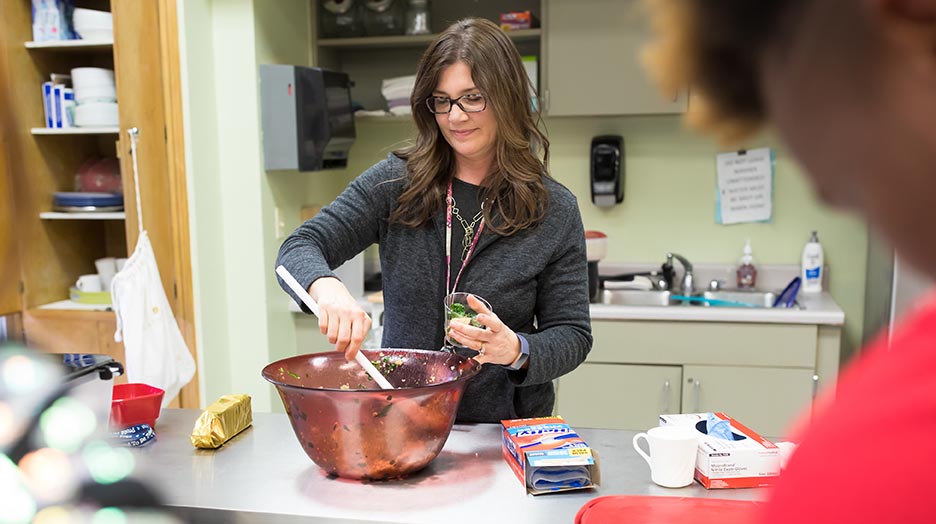Health and Well-being Children's nutrition
An early start to eating right
Food battles are a perennial theme of many parent/child conversations. Whether you’re dealing with a picky preschooler or stubborn teen, it’s not always easy to get kids to make healthy eating choices—especially when they’re old enough to make their own decisions.
Kelly Sierra understands the challenges all too well: A mom of three, she works as a dietitian at Loyola University Chicago’s School-based Health Center at Proviso East High School in Maywood, Illinois, where she offers group nutrition education and one-on-one nutrition counseling to teens.
“If kids are not consuming a nutrient-dense diet, they can become deficient in certain vitamins and minerals,” said Sierra, who completed Loyola’s Dietetic Internship Program in 2010 and also spent a year of culinary training at Le Cordon Bleu in London. “When kids frequently consume fast food and snacks that contain added sugars and saturated and trans fats, they are at an increased risk for heart disease, diabetes, obesity, high cholesterol, and high blood pressure.”
Sierra offers these tips to get kids and teens to make better eating choices:
Put it in context
Do you have a family history of heart disease, diabetes, or high blood pressure? If so, share that information with your kids. “We do a lot of nutrition education and talk about some of these chronic diseases,” Sierra said. “We explain that family history increases risk for certain nutrition-related conditions, but by making better food choices now, the risk decreases.”
Sierra also asks kids to consider a life with those health conditions: She has them touch the inside of their finger, noting how sensitive it is, and then tells them to imagine having to poke it with a needle three or four times a day to test their blood sugar, as they would have to do if they developed diabetes. It’s a bit of a scare tactic, she admits, but it emphasizes the reality and motives adolescents to make better choices.
Get your kids involved in cooking
This can work whether your child is a toddler or a teen. “Studies have shown that by involving your kids in the preparation and cooking of snacks and meals, they’ll be more likely to try new and healthy foods,” said Sierra. The same principle applies to grocery shopping: give your child a choice and let them pick a fruit or vegetable. They’ll be more likely to eat it if they’re the one who put it in the cart.
Eliminate sugary drinks
“Sugar-sweetened beverages are a primary reason behind childhood obesity,” said Sierra. She points out to kids how many teaspoons of sugar are hiding inside that brightly colored beverage: for example, nine teaspoons of sugar in a 16-ounce bottle of Gatorade, 10 in a 12-ounce can of soda, and a whopping 22 in a McDonald’s smoothie. “We do a lot of label reading. Kids don’t realize that if the Brisk Sweet Tea label says 65 calories per serving, they have to multiply all of the label information by four because there are actually four servings in one bottle.”
Limit sugary foods
“Sugar is somewhat addicting,” she said. “It’s important to understand that when you consume excess amounts of sugar, it increases the neurotransmitter dopamine, which signals the pleasure center of your brain. So if you give a child a little bit of sugar, they’re going to want more.”
At the same time, a little bit of sweetness can help the fruits and vegetables go down. Some picky toddlers will eat anything as long as it’s served with a dip, so try dipping apples in yogurt to make them more interesting. Adding chocolate sprinkles—even to a mashed potato or vegetable—can also tempt younger picky eaters to try something new.
Don’t forget the milk
“Calcium is an under-consumed nutrient amongst adolescents, and it’s super important because kids and teens are building the strength of their bones,” Sierra explained.
“Many teenagers don’t like to drink milk. We give kids milk in elementary school, and when they’re able to make their own decisions about what they eat and drink, they often switch to other non-dairy sugar-sweetened beverages.” Encourage your child to consume three servings of milk or other calcium-rich foods, like yogurt or cheese, every day.




